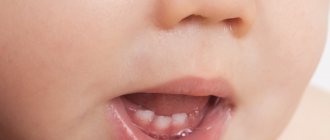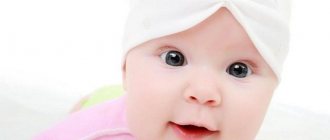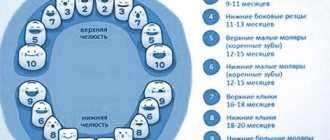How teeth are cut: the order in which they appear
Every adult can understand how a baby feels when his first teeth are cut - just remember how the so-called “wisdom teeth” appeared.
Swelling of the gums, itching and pain - you must admit, this is not pleasant. Therefore, infants often become capricious during the teething process. They may lose appetite and sleep, and even have a slight rise in temperature. The earliest time for baby teeth to erupt is at the incisors (front teeth). There are four of them on each jaw. As a rule, the lower two incisors erupt first (at 6-8 months), then the upper central incisors. The teeth appear in pairs opposite to each other, this is important for the formation of a correct primary bite. At 8-12 months, the baby develops lateral incisors (first on the lower jaw, then on the upper). At one year old, a child should have eight teeth. After this there is a short break in their appearance.
Next in the sequence are fangs. There are two of them on each jaw. The location and structure of these teeth makes their eruption especially difficult and difficult for the child. At the age of 16-20 months, fangs will appear on the lower jaw, and then on the upper jaw. Then comes the turn of the painters (large molars). They begin to erupt at 20-30 months, each child at its own time. There are a total of 20 teeth in the primary occlusion, 10 on each jaw: 4 incisors, 2 canines and 4 painters. All of them should appear by 2.5-3 years.
Ways to relieve discomfort
To make teething easier for your baby, you need to:
- provide additional attention and care from parents;
- if the baby is breastfed, put him to the breast more often, as this has a slight sedative effect;
- purchase several silicone teethers that can be cooled and offered to the child throughout the day;
- massage the gums with a finger wrapped in a clean gauze swab or a special silicone nozzle;
- promptly blot away any saliva with a clean napkin to avoid irritation of the skin around the mouth;
- if necessary and in consultation with a doctor, use medications.
Today, there are pharmacological and non-pharmacological methods of therapy for the eruption of primary teeth.
Local preparations
As a symptomatic aid for severe discomfort associated with teething, the pediatrician prescribes gels and ointments.
Such gels and ointments for teething with proven effectiveness are divided into 3 groups [1]:
- Preparations with an anesthetic effect based on anesthetic (lidocaine, choline, benzocaine). Sometimes lidocaine-based drugs contain anti-inflammatory or antiseptic components, providing a combined effect of the gel.
- Medicines based on anti-inflammatory or antiseptic agents.
- Preparations based on medicinal plant extracts. They use extracts of Roman chamomile, boswellia, aloe, marshmallow, Indian ivy, rhubarb, calendula and other components of plant origin.
Homeopathic remedies for teething are also produced, but their effectiveness has not been scientifically proven [1].
Systemic drugs
In cases of severe pain and hyperthermia, non-steroidal anti-inflammatory drugs are used, which reduce body temperature and have a systemic analgesic effect. The dosage and drug suitable for the child should be selected by a pediatrician.
Distractions
These include: the gum massage described above and baby teethers, which help the child temporarily reduce itching in the gums.
Signs of teething
How can parents understand that their child is teething? The easiest way to find out about this is by the child’s changed behavior. He sleeps worse and is capricious. He loses his appetite (may completely refuse to eat). But similar symptoms can be caused by other reasons. Therefore, the most obvious sign can be considered swelling of the gums (a small red bump appears on it, which parents can feel rather than see).
The child's changed behavior is associated with the movement of the tooth in the jaw. It seems to tear the gums from the inside, which explains the unpleasant sensations: itching, burning and pain. To remove them, the child can scratch his gums, pull various objects into his mouth, and bite. You cannot stop this behavior; you just need to replace inappropriate objects (for example, toys) with special teethers, the purpose of which is to help relieve the unpleasant consequences of teething.
It is because of the unpleasant sensations that the child may begin to refuse food, especially hot food (increases the pain). A light massage of the gums may help, which should be performed before feeding. It will relieve some of the itching and pain.
During teething, the baby's temperature can rise to 38º, but not higher. Until the teeth appear, parents should pay as much attention to the child as possible, distracting him from unpleasant sensations. This will help the baby get through a difficult time for him.
Replacing baby teeth with permanent teeth
Eruption of molars begins at the age of 6-7 years. First, the large molars are shown (usually on the lower jaw). Then the pattern of baby teeth eruption is repeated. The incisors on the lower jaw are the first to change, and at the age of 7-8 years, the incisors on the upper jaw are also replaced. At the same time, the lower lateral incisors can also change.
At 8-9 years old, the upper incisors will change. It's the fangs' turn. At the same time (9-10 years), teeth that were not in the primary occlusion - premolars - begin to grow. There are four premolars on each jaw - two on the left and two on the right. At the age of 12, the fangs on the upper jaw will change. At this stage, the formation of the height of the bite begins, which has both aesthetic and functional significance.
The last teeth (wisdom teeth or third molars) appear between the ages of 17 and 25. Only after this can we say that the formation of the dental arches is completely completed.
When replacing baby teeth with permanent molars, it is important to pay attention to the bite. It is easy to correct at a young age, while adults will have to correct it throughout their lives. By regularly visiting a pediatric dentist, you can intervene in the process of bite formation in a timely manner. In addition, a specialist can monitor the eruption of baby and molar teeth (so that it is not too early or late), give recommendations to alleviate the child’s condition, and recommend special baby suppositories or gels for teething.
All about teething in babies...
...and children in the first years of life. So I was happy early on - the first two lower teeth came out without any problems, and I was already glad that everything was okay with us. But that was not the case... For half a day now, my Mashulya has been restless... hot (temp 37.8 and liquid poop)))). Saliva streamed, and whining, whining, whining... The doctor denied any disease. There is only one diagnosis: teeth. So I scoured the Internet and found some information. How to recognize, distinguish and act correctly. Maybe it will be useful to someone... Teething in children in the vast majority of cases begins at the age of 4-7 months and occurs in a more or less precise sequence (incisors, premolars, canines, molars). And small deviations from this period should not alarm parents. Many children become restless and capricious during teething. Often, against the background of teething, the child develops profuse salivation, inflammation of the gums, fever, mild runny nose, wet cough or diarrhea. To facilitate teething, it is recommended to give the child special rubber rings or toys to develop the gums, and in case of severe gum pain, use special pain-relieving gels. Typically, teeth appear in the following order: first incisors (upper and lower), second incisors (upper and lower), first molars (upper and lower), canines (upper and lower), and finally second molars ( top and bottom). By age 3, a child should have a full row of 20 teeth, which should not fall out until about 6 years of age, when permanent teeth are ready to emerge. Just like the timing of teething, the symptoms that accompany this process can be very diverse in different children and even change from case to case in the same child. For many children and their parents, the process of teething is quite difficult and painful; in other cases, the child does not show any signs of teeth appearing all the time, and happy parents notice his “new things” completely by accident.
The first signs of teething are heavy salivation and painful, swollen gums. These teething symptoms may occur as early as a month or two before the tooth can be seen. Because of the discomfort and pain, some children may sleep restlessly, be fussy, lose their appetite, and want to chew on hard objects or put their fingers in their mouth. Closer to the moment the tooth appears, you can notice a whitish protrusion or a thin white line on the gum, which produces a characteristic ringing clicking sound if you gently tap it with a teaspoon (some enterprising parents sometimes do this).
Diarrhea, runny nose, cough and fever as symptoms of teething - Doctors differ on whether teething causes symptoms such as diarrhea, runny nose, wet cough and fever. Despite the fact that in certain cases the connection between the deterioration of the child’s condition and the appearance of teeth is almost obvious, most doctors do not include fever, runny nose, cough and diarrhea in the list of possible manifestations of teething. This attitude has a logical explanation: in many cases, teething in children can last the first 2-3 years of life and coincides with the period of greatest risk of various infections, and therefore it is incorrect and dangerous to “write off” every episode of fever, cough, diarrhea or runny nose due to teething. However, an increase in temperature, the appearance of a runny nose, mild diarrhea and a wet cough against the background of teething is possible and occurs quite often.
An increase in temperature during teething is associated with the release of a large amount of biologically active substances in the tooth growth zone. In most cases, the increase in temperature during teething does not exceed 38.5 C - 39 C and lasts no more than 1-2 days. To reduce fever in children, it is recommended to use Paracetamol. In all cases when the child’s temperature exceeds 39 C or lasts more than 2 days, he should be shown to a doctor. The appearance of diarrhea during teething is explained by strong salivation (the child swallows a lot of saliva) and accelerated intestinal motility. Diarrhea due to teething is usually watery, not very frequent (up to 2-3 times a day) and lasts no more than 1-3 days. In all cases when a child experiences frequent watery or bloody diarrhea (more than 3 times a day), characteristic of an intestinal infection, the child should be shown to a doctor. See also Diarrhea.
The appearance of a runny nose during teething is explained by increased secretion of mucus by the glands of the nasal cavity. A runny nose due to teething is watery (the mucus is clear and runny), not very profuse and lasts no more than 3-4 days. Treatment of a runny nose in children during teething is best limited to clearing the nose of mucus. See also Runny nose. In all cases when a child has a profuse purulent (greenish or whitish runny nose) which is accompanied by severe nasal congestion and lasts more than 3 days, the child should be shown to a doctor.
The appearance of a wet cough during teething is explained by the accumulation of saliva in the throat, which is released in large quantities during teething. A wet cough during teething is quite rare, worsens when lying down and goes away within 2-3 days. This cough does not require any treatment. In all cases, when a child’s wet cough becomes frequent, is accompanied by the production of copious sputum, wheezing in the bronchi, shortness of breath, and lasts more than 2 days, the child should be shown to a doctor.
In order not to confuse teething with any disease, we recommend that all inexperienced parents call a doctor in all cases of fever, runny nose, diarrhea or cough in the child.
How can you help your baby during teething? During this difficult period for the child, parents should support him, pick him up more often, caress him, and distract him from the pain with interesting activities. If your baby is breastfed, he can be easily soothed by offering the breast. Most breastfed babies ask for the breast much more often during teething compared to normal days. You should not refuse your child, and especially you should not try to set any schedule these days or try to wean your child off the breast. Typically, such a “difficult period” lasts no more than 2-3 days. During teething, children often feel the urge to gnaw or chew on something. This helps them relieve discomfort. Offer your child a special rubber ring or other elastic rubber toy. Many sources recommend chilling the rubber ring in the freezer before giving it to your child. However, it is worth noting that many children do not like cold objects or are not at all interested in special toys for warming up their gums and choose their favorite object for this. In this case, you should not insist and give the child special rings. Just make sure that the item your child chooses does not have sharp ends that could cut the child or small parts that could cause a choking hazard. Some children prefer to chew on a crust of bread or a bagel while teething. Children switch very quickly from one mood to another. A child who has just sobbed with all his might can easily laugh and vice versa. Therefore, the best way to relieve a child's pain is to distract him from it. Find an interesting activity for your child, play with him, take a walk, and he will quickly forget about his discomfort. You should not think that if, when you feel bad, you prefer to lie in silence and relax, then this will be the best option for your child.
In case of severe soreness of the gums, which is manifested by severe crying, anxiety, and the child’s refusal to eat, you can use special gels designed to eliminate pain during teething. It is convenient to apply such gels to the child’s gums with your finger, gently massaging them.
If a child has the above symptoms that last more than 1-2 days, be sure to show the child to a doctor. There are cases when doctors do not find any disease and then it can be assumed that it could be caused by teething. However, in many cases, these symptoms are caused by a serious illness, such as otitis media, food poisoning, viral infection, etc. Therefore, you should not immediately write off the signs of the disease as teething, because this way you may miss a serious disease, which can result in extremely unpleasant consequences. The body of a small child is not yet able to cope with many diseases, so if there are obvious signs of illness, it is better to consult a doctor once again than to go too late.
Of all the manifestations of teething described above, only temperature requires treatment and only if it rises above 38.5 C. Runny nose, cough or diarrhea caused by teething do not require any treatment.






